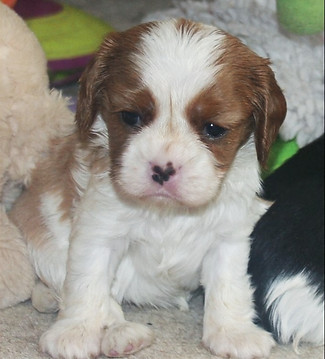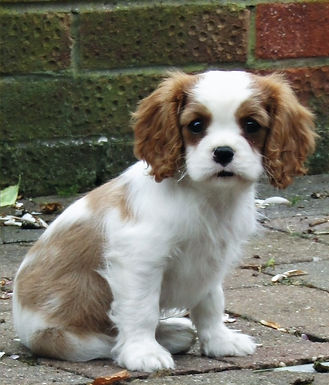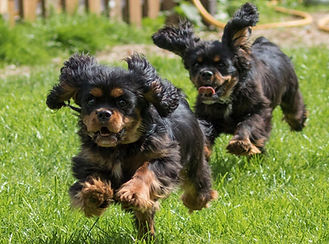
Carsan Cavaliers







New Puppy
Puppy-proofing your home and garden.
Your home is full of dangers for an inquisitive puppy. Try padding through your house on your hands and knees to see the world from your pup's perspective. Before it arrives:
-
Remove all breakable ornaments that your pup might reach.
-
Place all houseplants out the way and remove any that are poisonous or may cause gastric upsets if chewed. If you’re not sure ask for advice in your garden centre.
-
Hide all trailing electrical cables behind furniture.
-
Check the lower sections of bookshelves, and replace any valuable books with telephone directories, or something you don’t mind being a bit chewed.
-
Place all shoes in cupboards.
-
Remove or shorten hanging tablecloths - puppies are expert at clearing a fully-laid table!
-
Fit child locks on floor level kitchen cupboards, especially if there are cleaning materials inside.
Once your puppy is booked you might want to ask the breeder if they could place a towel of yours in with the litter's bedding for a couple of days before collection. Then you can bring home the towel with the puppy. The familiar scent will act as a little comfort blanket in amongst all the new sights, smells and sounds of its new home.
Puppy-safe your garden
Gardens may be the big attraction for new arrivals, but the great outdoors can be fraught with perils:
-
Your garden should be fully fenced, at the correct height for the breed you’re buying (most medium-sized breeds need a six-foot fence).
-
Check there are no gaps that your puppy can squeeze through or under, and make sure that the fence panels are sunk well into the ground or mesh the verge into the garden by three-four feet. Terriers in particular are big diggers.
-
Swimming pools and ponds should also be fenced off securely, or covered firmly when not in use.
-
If you are a keen gardener, then fence off your prize petunias! Consider building your puppy a sand or mud pit that it can dig in.
There are many plants, shrubs and trees that are poisonous to dogs. You should always discourage your puppy from chewing anything that it finds in the garden, and contact your vet if you are concerned. If you would prefer to play safe and remove all toxic plants, ask for advice in your garden centre.
Shopping for your puppy
Now is the time to shop for all the important puppy accessories:
-
Crate or indoor kennel: A must-have for all puppy owners. Although some models look like an uninviting cage, lined with some comfortable bedding, an indoor kennel is easily transformed into a cosy doggie den. Make sure you buy a size that will accommodate your puppy when it is a fully grown adult – your dog must be able to stand up and turn around with ease.
-
Car safety: You may want a crate for the car too. Alternatively car safety harnesses are available that fit around the dog and attach to the seatbelt in the rear of your car. There are lots of other useful car accessories to consider, from travel blankets and non-spill bowls, to special air fresheners that act fast on essence of ‘wet dog’.
-
Clothing: Some breeds, particularly those with short-coats originally from hot climates, such as Greyhounds, prefer coats during cold weather. Ask your breeder if this is necessary for your chosen breed.
-
Toys: Buy good-quality toys that can withstand the attention of a puppy's sharp teeth. Some dogs, such as Terriers, love squeaky toys, but do check toys regularly for any sign of damage, as a puppy could remove and swallow the 'squeak', and choke. Other breeds, such as retrievers, enjoy carrying around soft toys, or, like Collies, prefer balls. Always make sure the toy is larger than the puppy's throat, and never allow unsupervised play with tennis balls, which can collapse while being chewed, and then expand inside the dog if swallowed. Interactive toys, filled with Bakers Complete or the occasional treat, that the dog has to roll to retrieve are excellent for stimulating young brains.
-
Bowls: Your puppy will need one bowl for water, and another for food. There are all sorts on the market, and each has strengths and weaknesses. Plastic bowls are cheap, but do scratch and get chewed so need replacing regularly. They can also harbour germs if damaged. Ceramic bowls are easily cleaned, and look great, but can easily break with an excitable pup in the house. Stainless steel bowls are durable and easily cleaned, but may need securing in a bowl stand. This is especially recommended for the large and giant breeds who otherwise have a long way up to swallow their dinner! It's also worthwhile to keep a bowl (and bottle of water) in the car, in case the trip takes longer than expected.
-
Food: You’ll need to stock up before your new puppy arrives, but it’s not worth buying too much in advance, particularly if you intend to try your puppy out on a variety of dog food brands before making your final choice. Ask your breeder, or the shelter what diet the puppy has been fed before it comes home. It’s important, in the first week or two not to change your puppy’s diet. Once your puppy has settled, you can gradually alter its diet to by introducing the new brand slowly over a 5-10 day period.
-
Collar and lead: Your puppy will need a soft collar and a light lead. It is not used to wearing anything around its neck and will likely object to anything bulky or heavy. Make sure you can fit two fingers underneath the collar once it’s fitted. Any less and it will be too tight; any more and your pup will be able to back out of it. A harness or head-collar may also be a wise investment, to help ensure that your puppy never learns to pull on the lead.
-
Bedding: Avoid whicker baskets for hygiene and chewing reasons, and see above for information on indoor kennels. Old washed blankets or towels make a cosy covering, or a single duvet folded into two. Fleecy veterinary-type bedding is warm, absorbs water, and is easily washable too. It can be expensive, but is durable and cost-effective in the long term. Clean bedding regularly and check for signs of damage, such as chewing.
-
Grooming equipment: This will depend on your puppy's coat type. All dogs will need nail clippers, a toothbrush and doggie toothpaste, plus a mild dog shampoo. As for brushes and combs, ask the advice of your breeder - a short-coated breed may just need a grooming mit or glove, but a longer-coated puppy needs its own mini beauty salon!
-
Stair-gate: These can be useful for barring your puppy's access upstairs, or between rooms.
Finding a vet
Your relationship with your dog's vet is as important as your own with your doctor. You must trust them implicitly, and have complete faith in their diagnostic and surgical abilities. What to look out for:
-
Personal recommendations are a good starting place. What vet practices do dog-owning friends and neighbours use?
-
A specialist small-animal practice (rather than a mixed practice, that also deals with farm animals) may suit you better, as the vets are likely to be more experienced in dealing with dogs and maintain equipment and facilities specific for canine care and treatment.
-
Do the vets have any specialist qualifications (medicine, cardiology, oncology, dermatology) in small animals?
-
What are the opening times and do they fit in with your working hours, school runs, etc.?
-
What 24-hour emergency cover is offered? Is there a rota with other surgeries in the area? What’s the greatest distance you’d have to travel?
-
How well-equipped is the practice to deal with canine treatments? Ask for a tour.
-
Is the practice clean, and are the staff friendly?
-
Is the vet approachable? He or she must be able to explain things simply and clearly - communication skills are one of the most important parts of a vet's job.
-
Is there adequate parking? Or if you don't have your own transport, is the practice easy to get to by public transport?
-
Do the staff make home visits?
-
What 'extras' are on offer - grooming, weight-loss clinics, puppy parties, behaviour therapy, training, qualified nurse clinics, complementary medicine - either directly or on referral?
-
Is there a separate waiting area for cats and dogs to reduce excitement? If not, do they have species-specific appointment times?
To help you find your nearest practice, visit Find a Vet at http://www.any-uk-vet.co.uk
Discussing house rules
Before you bring your puppy home, it’s important to agree some house rules with all family members, especially children. Do you want your puppy to get up on the sofa for a cuddle, or is this a big no-no. Every house is different and it's up to you all to sort out what is, and isn't, acceptable behaviour - and then be consistent when the puppy arrives. You’ll also want to develop your family's dog vocabulary; which words you will all use to mean what during training and in general family life together. Here are a few useful starters:
-
Puppies need lots of sleep. When your puppy is in its crate, it shouldn’t be disturbed.
-
Teasing must be forbidden.
-
If your puppy bites, the victim should yelp loudly, and then ignore the puppy until it calms down.
-
Your puppy should never be given scraps from the table, this will encourage begging and may upset its digestion.
-
Decide where the puppy can and can’t go inside the house. Upstairs may be out of bounds (puppies shouldn't be allowed to climb stairs unsupervised), or the dining room, etc. Stair-gates can be used to restrict your puppy’s access.
-
Decide where the puppy will sleep - and stick to it. If you smuggle it into your bed because it cries, it will learn that screaming the house down at night brings a reward!
-
Young children shouldn’t pick up the puppy without supervision.
-
Your puppy shouldn’t be disturbed when eating. Get between a hungry puppy and its food and you might get a nip.
-
Draw up a rota of care. Who will feed and exercise the puppy and when? Training and grooming should be shared between all family members to build bonds.
-
Remember to keep doors and windows shut.
-
All family members should be warned that anything left on the floor is fair game for the puppy. Home-work, expensive trainers, handbags, laundry...everything should be out of reach!
Choosing a name
Decide on a name before bringing the puppy home, and tell the breeder your choice.
-
Names are best short and easy to say. Long names are a bit of a mouthful for you, can be pronounced slightly differently, and are therefore more difficult for your puppy to learn and get used to.
-
Short names have the added advantage that they can't be shortened to a selection of nicknames that will confuse the puppy further.
-
Don't choose a joke name. It will probably wear thin after 14 years or so and everyone’s forgotten the joke.
-
Make sure you choose a name that you are happy to call in public.
Copyright © 2024 Carol MacKenzie All rights reserved
Telephone 01945 700424













